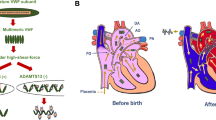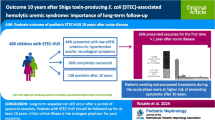Abstract
Thrombotic microangiopathies comprise different entities, including hemolytic uremic syndrome (HUS), thrombotic thrombocytopenic purpura (TTP), and several other conditions. TTP is characterized by hemolytic anemia, thrombocytopenia, and multiorgan failure. TTP is the result of severe von Willebrand factor multimer cleaving protease (ADAMTS13) deficiency that is either inherited or the result of acquired autoantibodies. We report a critically ill 2-year-old girl with invasive pneumococcal disease associated HUS (p-HUS) whose condition was complicated by severe ADAMTS13 deficiency, without detectable inhibitor, in a context of multiple organ failure. The patient recovered with supportive treatment, and ADAMTS13 activity normalized without plasmatherapy. Severe ADAMTS13 deficiency appears to be a manifestation of transient endothelial cell injury in the context of severe sepsis, including invasive p-HUS. The choice of appropriate therapy should not be based on this finding.
Similar content being viewed by others
Abbreviations
- HUS:
-
hemolytic uremic syndrome
- p-HUS:
-
pneumococcal hemolytic uremic syndrome
- STEC:
-
Shiga-toxin-producing Escherichia coli
- TF antigen:
-
Thomsen-Friedenreich antigen
- TTP:
-
thrombotic thrombocytopenic purpura
References
Copelovitch L, Kaplan BS (2008) The thrombotic microangiopathies. Pediatr Nephrol 23:1761–1767
Loirat C, Noris M, Fremeaux-Bacchi V (2008) Complement and the atypical hemolytic uremic syndrome in children. Pediatr Nephrol 23:1957–1972
Besbas N, Karpman D, Landau D, Loirat C, Proesmans W, Remuzzi G, Rizzoni G, Taylor CM, Van de Kar N, Zimmerhackl LB, European Paediatric Research Group for HUS (2006) A classification of hemolytic uremic syndrome and thrombotic thrombocytopenic purpura and related disorders. Kidney Int 70:423–431
Loirat C, Veyradier A, Girma JP, Ribba AS, Meyer D (2006) Thrombotic thrombocytopenic purpura associated with von Willebrand factor-cleaving protease (ADAMTS13) deficiency in children. Semin Thromb Hemost 32:90–97
Harambat J, Lamireau D, Delmas Y, Ryman A, Llanas B, Brissaud O (2010) Successful treatment with rituximab for acute refractory thrombotic thrombocytopenic purpura related to acquired ADAMTS13 deficiency: a pediatric report and literature review. Pediatr Crit Care Med. doi:10.1097/PCC.0b013e3181e89f8f
Martin K, Borgel D, Lerolle N, Feys HB, Trinquart L, Vanhoorelbeke K, Deckmyn H, Legendre P, Diehl JL, Baruch D (2007) Decreased ADAMTS-13 (A disintegrin-like and metalloprotease with thrombospondin type 1 repeats) is associated with a poor prognosis in sepsis-induced organ failure. Crit Care Med 35:2375–2382
Nguyen TC, Liu A, Liu L, Ball C, Choi H, May WS, Aboulfatova K, Bergeron AL, Dong JF (2007) Acquired ADAMTS-13 deficiency in pediatric patients with severe sepsis. Haematologica 92:121–124
Constantinescu AR, Bitzan M, Weiss LS, Christen E, Kaplan BS, Cnaan A, Trachtman H (2004) Non-enteropathic hemolytic uremic syndrome: causes and short-term course. Am J Kidney Dis 43:976–982
Waters AM, Kerecuk L, Luk D, Haq MR, Fitzpatrick MM, Gilbert RD, Inward C, Jones C, Pichon B, Reid C, Slack MP, Van't Hoff W, Dillon MJ, Taylor CM, Tullus K (2007) Hemolytic uremic syndrome associated with invasive pneumococcal disease: the United kingdom experience. J Pediatr 151:140–144
Copelovitch L, Kaplan BS (2010) Streptococcus pneumonia-associated hemolytic uremic syndrome: classification and the emergence of serotype 19A. Pediatrics 125:e174–e182
Klein PJ, Bulla M, Newman RA, Müller P, Uhlenbruck G, Schaefer HE, Krüger G, Fisher R (1977) Thomsen-Friedenreich antigen in haemolytic-uraemic syndrome. Lancet 2:1024–1025
Novak RW, Martin CR, Orsini EN (1983) Hemolytic-uremic syndrome and T-cryptantigen exposure by neuraminidase-producing pneumococci: an emerging problem? Pediatr Pathol 1:409–413
Pan CG, Leichter HE, Werlin SL (1995) Hepatocellular injury in Streptococcus pneumoniae-associated hemolytic uremic syndrome in children. Pediatr Nephrol 9:690–693
Dekan G, Gabel C, Farquhar MG (1991) Sulfate contributes to the negative charge of podocalyxin, the major sialoglycoprotein of the glomerular filtration slits. Proc Natl Acad Sci USA 88:5398–5402
Gelberg H, Healy L, Whiteley H, Miller LA, Vimr E (1996) In vivo enzymatic removal of alpha 2-->6-linked sialic acid from the glomerular filtration barrier results in podocyte charge alteration and glomerular injury. Lab Invest 74:907–920
Suzuki H, Moldoveanu Z, Hall S, Brown R, Vu HL, Novak L, Julian BA, Tomana M, Wyatt RJ, Edberg JC, Alarcón GS, Kimberly RP, Tomino Y, Mestecky J, Novak J (2008) IgA1-secreting cell lines from patients with IgA nephropathy produce aberrantly glycosylated IgA1. J Clin Invest 118:629–639
Brandt J, Wong C, Mihm S, Roberts J, Smith J, Brewer E, Thiagarajan R, Warady B (2002) Invasive pneumococcal disease and hemolytic uremic syndrome. Pediatrics 110:371–376
Hopkins CK, Yuan S, Lu Q, Ziman A, Goldfinger D (2008) A severe case of atypical hemolytic uremic syndrome associated with pneumococcal infection and T activation treated successfully with plasma exchange. Transfusion 48:2448–2452
Hunt BJ, Lämmle B, Nevard CH, Haycock GB, Furlan M (2001) von Willebrand factor-cleaving protease in childhood diarrhoea-associated haemolytic uraemic syndrome. Thromb Haemost 85:975–978
Veyradier A, Obert B, Haddad E, Cloarec S, Nivet H, Foulard M, Lesure F, Delattre P, Lakhdari M, Meyer D, Girma JP, Loirat C (2003) Severe deficiency of the specific von Willebrand factor-cleaving protease (ADAMTS 13) activity in a subgroup of children with atypical hemolytic uremic syndrome. J Pediatr 142:310–317
Gerth J, Busch M, Oyen F, Schneppenheim R, Keller T, Budde U, Groene HJ, Wolf G (2007) Thrombotic microangiopathy in a 17-year-old patient: TTP, HUS or a bit of both? Clin Nephrol 68:405–411
Nguyen TC, Han YY, Kiss JE, Hall MW, Hassett AC, Jaffe R, Orr RA, Janosky J, Carcillo JA (2008) Intensive plasma exchange increases a disintegrin and metalloprotease with thrombospondin motifs-13 activity and reverses organ dysfunction in children with thrombocytopenia-associated multiple organ failure. Crit Care Med 36:2878–2887
Huang DT, Chi H, Lee HC, Chiu NC, Huang FY (2006) T-antigen activation for prediction of pneumococcus-induced hemolytic uremic syndrome and hemolytic anemia. Pediatr Infect Dis 25:608–610
Grewal PK, Uchiyama S, Ditto D, Varki N, Le DT, Nizet V, Marth JD (2008) The Ashwell receptor mitigates the lethal coagulopathy of sepsis. Nat Med 14:648-655
Acknowledgements
We thank Pr. Agnes Veyradier and her collaborators, Hôpital Antoine Béclère, Paris, for carrying out the confirmatory ADAMTS13 activity measurements.
Author information
Authors and Affiliations
Corresponding author
Rights and permissions
About this article
Cite this article
Pelras, S., Delmas, Y., Lamireau, D. et al. Severe transient ADAMTS13 deficiency in pneumococcal-associated hemolytic uremic syndrome. Pediatr Nephrol 26, 631–635 (2011). https://doi.org/10.1007/s00467-010-1721-9
Received:
Revised:
Accepted:
Published:
Issue Date:
DOI: https://doi.org/10.1007/s00467-010-1721-9




